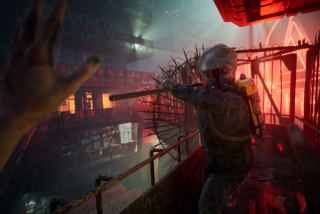Slaying dragons, starting trends
- Share via
Dirk the Daring sure doesn’t look like much of a revolutionary. He is a flat-footed knucklehead in unshining armor, in way over his head on a quest to rescue the girl from a fire-breathing dragon. But two decades ago, Dirk was a pioneer in the convergence of video games and movies that is now a major trend in on-screen entertainment.
Dirk was the hero of Dragon’s Lair, a 1983 arcade game with rare cinematic qualities, marrying classic hand-painted animation with laser-disc technology. As it turns out, its film-like interface with the player was a sneak peak at the future.
“The game people know very well they’re in competition with the movie people,” says veteran animator Don Bluth, whose studio brought Dirk to life in that first game.
He has now returned for the new Dragon’s Lair 3D: Return to the Lair, debuting on Xbox in November. “It will be a competition to see who will put the best visuals on the screen.” Today, it’s not unusual for major game makers to recruit actors, writers and technical experts from Hollywood. But in the early ‘80s, Dragon’s Lair broke through game barriers of storytelling and budget, spending $100,000 for each of the game’s 20 minutes of animation.
The game was a major departure from the likes of Ms. Pac-Man and Defender in that the graphics were not computer-generated. Instead, players were shown a few seconds of traditional film animation that led up to a challenge requiring a particular move with the joystick, before continuing on to the next part of the story.
Dragon’s Lair was a major hit, and is one of only three video games in the Smithsonian Institution. The continuing merger of games and cinema, however, made the classic prime for a remake.
“We weren’t that smart back then,” jokes Rick Dyer, a young game designer and animation fanatic when he first approached Bluth in 1982. “We just had a vision ... somehow we figured out a way to make it.”
Three years ago, Bluth was approached again by Dyer, now CEO of Dragonstone Software in Diamond Bar, who told him that technology now existed to re-create the look of the original game and make it a fully interactive, 3-D experience. “I got really excited at that point,” Bluth says.
Dragon’s Lair 3D is the first true sequel to the game, re-creating the fluid look of classic animation as a 3-D game. It is also designed for high-definition TV, and variations of Dragon’s Lair will be available for PC and the new generation of consoles (PlayStation 2, Xbox and GameCube) from publishers Ubi Soft and Encore.
To create the new game, Bluth and Dragonstone drew on many of the original’s vintage backgrounds and cels as a guide. Bluth’s studio in Phoenix also created new opening and closing animated sequences, which blend almost seamlessly with the computerized game play.
“We walked into it not as gamers, but as filmmakers,” says Bluth, whose career includes several Disney classics, along with such films as 1982’s “Secret of NIMH” and 2000’s “Titan A.E.”
Now, after nearly five decades as an animator, he’s found that many consider Dirk the Daring his most memorable creation.
In 1982, “we went in there thinking this was a pit stop while we were waiting to make the next film,” says Bluth, who now has a Dragon’s Lair animated feature in pre-production. “But it turns out that this is the thing we’ll be most remembered for.
“Isn’t that weird? But I’m OK with that.”
*
New day for knight
Street date: Debuts for Xbox and PC on Nov. 18
Platforms: Also to be released for GameCube and PlayStation 2 in January; Macintosh in early 2003.
Cost: Consoles, $49.99; PC and Mac, $29.99
Web address: www.dragonslair3d.com
More to Read
The biggest entertainment stories
Get our big stories about Hollywood, film, television, music, arts, culture and more right in your inbox as soon as they publish.
You may occasionally receive promotional content from the Los Angeles Times.











